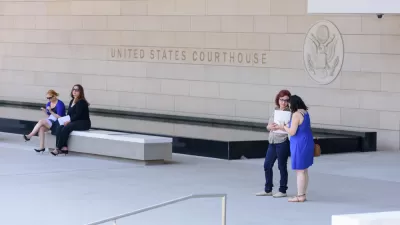According to data from the most recent Census, segregation along racial lines has hit an 100-year low in seventy-five percent of U.S. metropolitan areas. Southern and Western cities have showed the most noticeable integration trends.
New figures released by the U.S. Census Bureau indicate that racial boundaries are fading in many American neighborhoods within metropolitan areas. The data was collected through the Census Bureau's American Community Survey, which, with 10 million participants, is the largest demographic survey ever completed in the country.
Of particular interest to politicians and lawmakers alike is the Congressional redistricting issues that have emerged as racial demographics change according to geographical location.
"The shift is part of a 'complicated story with lots of nuances' that includes changes in social attitudes, the emergence of new housing and economic opportunity, and an age gap that shows young America is dramatically more diverse – and open to diversity – than older generations, says Kenneth Johnson, a demographer at the University of New Hampshire, in Durham."
" 'Whether you like it or not, [the new figures] show that change is coming,' says Mr. Johnson."
FULL STORY: Census: Segregation hits 100-year lows in most American metro areas

Study: Maui’s Plan to Convert Vacation Rentals to Long-Term Housing Could Cause Nearly $1 Billion Economic Loss
The plan would reduce visitor accommodation by 25,% resulting in 1,900 jobs lost.

North Texas Transit Leaders Tout Benefits of TOD for Growing Region
At a summit focused on transit-oriented development, policymakers discussed how North Texas’ expanded light rail system can serve as a tool for economic growth.

Why Should We Subsidize Public Transportation?
Many public transit agencies face financial stress due to rising costs, declining fare revenue, and declining subsidies. Transit advocates must provide a strong business case for increasing public transit funding.

How to Make US Trains Faster
Changes to boarding platforms and a switch to electric trains could improve U.S. passenger rail service without the added cost of high-speed rail.

Columbia’s Revitalized ‘Loop’ Is a Hub for Local Entrepreneurs
A focus on small businesses is helping a commercial corridor in Columbia, Missouri thrive.

Invasive Insect Threatens Minnesota’s Ash Forests
The Emerald Ash Borer is a rapidly spreading invasive pest threatening Minnesota’s ash trees, and homeowners are encouraged to plant diverse replacement species, avoid moving ash firewood, and monitor for signs of infestation.
Urban Design for Planners 1: Software Tools
This six-course series explores essential urban design concepts using open source software and equips planners with the tools they need to participate fully in the urban design process.
Planning for Universal Design
Learn the tools for implementing Universal Design in planning regulations.
City of Santa Clarita
Ascent Environmental
Institute for Housing and Urban Development Studies (IHS)
City of Grandview
Harvard GSD Executive Education
Toledo-Lucas County Plan Commissions
Salt Lake City
NYU Wagner Graduate School of Public Service




























